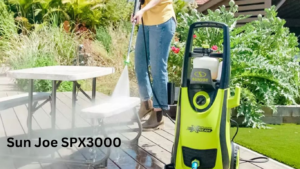Converting your pressure washer into sewer pipe is the best aid to clean your sewer pipes on a budget. Therefore, learning how to convert your pressure washer into a sewer jetter can be a life savior.
Luckily, today, we’ll walk you through the step-by-step process, ensuring safety and efficiency in the modification. Say goodbye to clogged drains and costly plumbing bills and get ready to embark on this exciting DIY project.
Understanding The Basics
Firstly, it’s essential to understand the fundamental difference between a pressure washer and a sewer jetter.
- A pressure washer is excellent for surface cleaning.
- A sewer jetter is designed specifically for clearing debris and blockages from sewer pipes.
Converting your pressure washer into a sewer jetter allows you to harness its power for this specialized task, making it a versatile tool.
Safety Precautions
Your safety is of paramount importance during any DIY project. Before getting started, ensure you have the right safety gear, including gloves, goggles, and appropriate footwear.
Additionally, always release pressure and disconnect the pressure washer from its power source. Following these safety precautions will prevent accidents and injuries during the conversion process.
How to Convert Your Pressure Washer into a Sewer Jetter:
Gather the Required Materials
To convert your pressure washer into a sewer jetter, you’ll need the following materials;
- Pressure Washer
- Pressure Hose
- Jetter Nozzle
- Water Wand
- Button and Angle Laser
- Rubber Gloves
- Pipe (Fluid Conveyance)
- Ball Valve
- Quick Coupler
Preparing Your Pressure Washer
Before you start the conversion, carefully read and follow the manufacturer’s guidelines for your pressure washer. Although, this step-by-step guide will ensure that you disassemble and prepare your pressure washer correctly, making it ready for modification. Be diligent in disconnecting hoses and power sources safely.
Building the Jetter Nozzle
The jetter nozzle is a crucial component for effective sewer jetting. In this section, we’ll explain the design and function of the jetter nozzle and provide you with a step-by-step guide on how to build your DIY version. Visual aids and diagrams will enhance your understanding and make the construction process a breeze.
Connecting the Jetter Nozzle
With your DIY jetter nozzle ready, it’s time to attach it to your pressure washer securely. A proper connection is essential to avoid leaks and potential accidents during use.
Setting Up the Pressure Washer
Once the jetter nozzle is connected, you’ll need to adjust the pressure settings for optimal sewer jetting.
Sewer Jetting Technique
Cleaning sewer pipes effectively requires the right technique. Our experts will provide you with valuable tips on proper jetting, emphasizing the significance of starting with low pressure and gradually increasing it. Mastering this technique will yield exceptional results in your sewer cleaning endeavors.
Troubleshooting and Maintenance
As with any DIY project, challenges may arise during the sewer jetting process. In this section, we’ve compiled common issues you might encounter and their troubleshooting solutions. Additionally, we’ll stress the importance of regular maintenance to extend the life of your modified pressure washer.
Conclusion
Converting your pressure washer into a sewer jetter is a game-changer. We’ve highlighted the benefits of this DIY project, ensuring your sewer jetting journey is safe, efficient, and environmentally friendly. Remember to follow safety precautions and guidelines throughout the process for a successful conversion.
Frequently Asked Questions
What is the difference between a pressure washer and a sewer jetter?
Pressure washers are designed for surface cleaning. Using high-pressure water to remove dirt, grime, and debris from various surfaces like driveways, patios, and vehicles. On the other hand, a sewer jetter is a specialized tool for cleaning sewer pipes and drains. It delivers a high-pressure stream of water to dislodge and clear blockages, such as tree roots, grease, and other debris, from sewer lines.
Can I find budget-friendly materials for the conversion?
Yes, you can find budget-friendly materials for the conversion. Look for affordable pressure hoses, jetter nozzles, and other required components at local hardware stores or online marketplaces. Additionally, you may explore DIY options for some parts, which can help you save money while achieving the desired results.
How do I ensure a secure connection for the DIY jetter nozzle?
To ensure a secure connection for the DIY jetter nozzle, follow these steps:
Use appropriate fittings and adapters that fit the pressure hose and nozzle.
Tighten the connections carefully, ensuring they are leak-proof.
Double-check the connection before using the modified pressure washer to prevent accidents or water leaks.
What pressure level should I use for sewer jetting?
The pressure level for sewer jetting may vary depending on the condition of your sewer pipes. It is recommended to start with low pressure and gradually increase it until you achieve the desired cleaning effect. Be cautious not to use excessively high pressure, as it may cause damage to older or fragile pipes.
How do I troubleshoot common issues during sewer jetting?
Common issues during sewer jetting may include insufficient water flow, nozzle clogs, or reduced cleaning effectiveness. Here are some troubleshooting tips:
Check for kinks or obstructions in the pressure hose that may restrict water flow.
Clean the jetter nozzle regularly to prevent debris buildup.
Adjust the pressure settings and technique to improve cleaning efficiency.
If issues persist, consult a professional plumber for further assistance.







